Stucco and the blind man
Chapter 10: Glossary of plastering terms.
Here is some vocabulary used in plastering, and of course, cement plaster.
Once you are hip to the bop lingo, you can shoot the jive with all the hep cats. Be a cool daddy-o and not like, from Squaresville.
Angle- An inside corner in plaster and drywall, for example, the intersection of a wall and ceiling.
Angle float- A tool for plastering angles. Shown is an aluminum angle float. They make a plexiglass angle
float for color plaster that won't mark off on the wall. There is a stainless steel angle float. The corners are slightly rounded on a stainless steel angle float. These are great to help hide crooked angles doing patchwork.
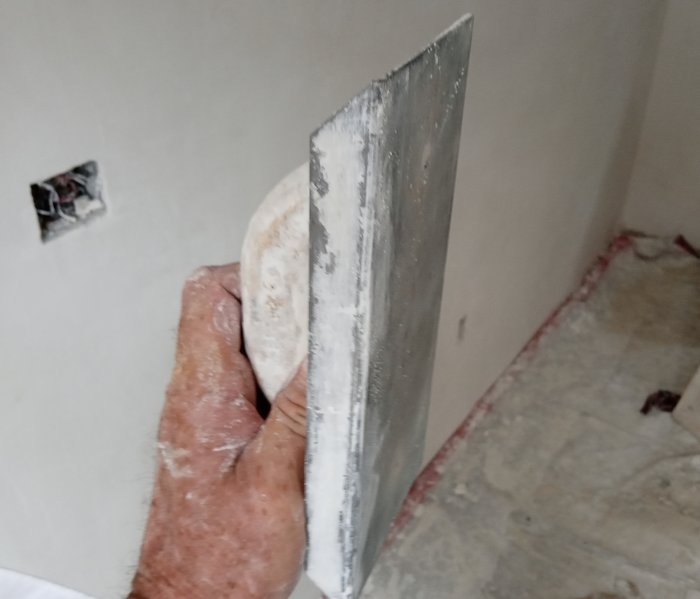
Arris- An outside corner in plastering. A corner is the intersection of angles or arrises.
Back trowel- Using the trowel for a rod pulling the trowel backwards across the wall. This leaves the surface nice and rough for the finish coat. I can take a picture when I remember.
Bag finish- Textures on stucco made with a burlap bag. Here are some examples: (scoll down)
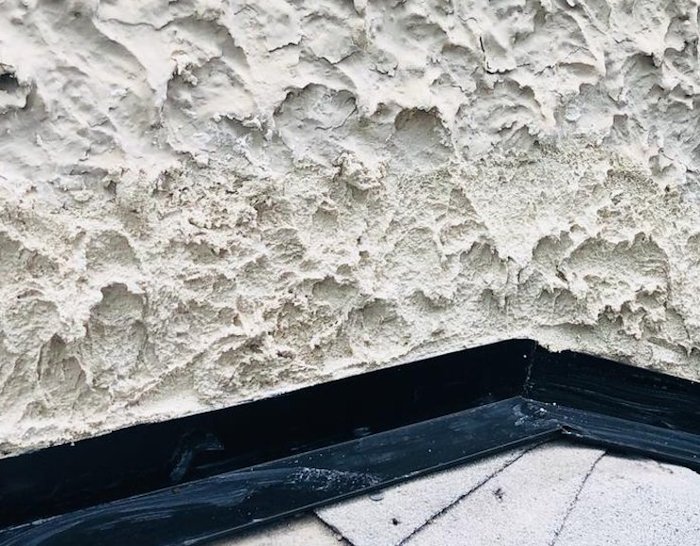
Blister brush-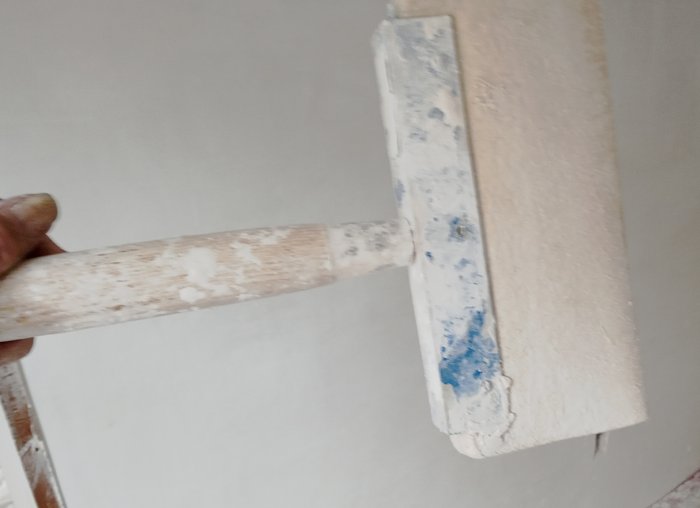 A felt brush made for applying
water to the white coat when troweling the wall smooth. Applying water prevents the trowel
from sticking to the work. Also known as a mop, these mops have replaceable pads.
A felt brush made for applying
water to the white coat when troweling the wall smooth. Applying water prevents the trowel
from sticking to the work. Also known as a mop, these mops have replaceable pads.
Blue heads-Blue heads are dark spots where the brown coat shows through the finish coat. Even though these are usually small and are covered with paint, it looks like the white coat is real skimpy. Blue heads can be chopped out and filled in. If there are too many blueheads, the wall can have another finish coat put on while it is still green.
Blue skim- Blue skim is when brown mortar with no aggregate, or neat plaster, is used gauged with lime putty instead of using gauging plaster with lime putty. This method works good, it is just brown instead of white. Blue skim is super hard.
Brown mortar-Gypsum plaster for a plaster basecoat. This is neat plaster mixed with sand or lightweight aggregate, like perlite or vermiculite.
Brown coat- is the basecoat on stucco or conventional plaster. This is when the basecoat mortar, either plaster or cement, is straightened with a rod, or rodded off.
Browning brush-Also known as a utility brush, a brush used to splash water on the wall, the mortar board, mortar or whatever. These are also used for washing tools.
Casing bead-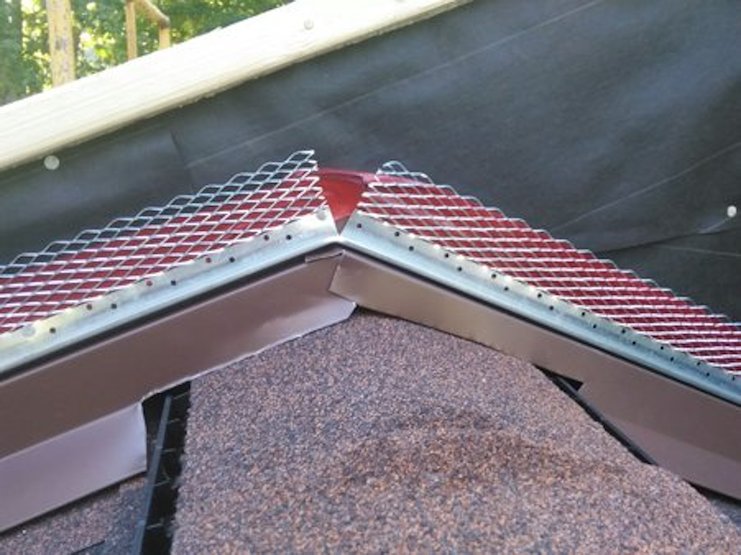
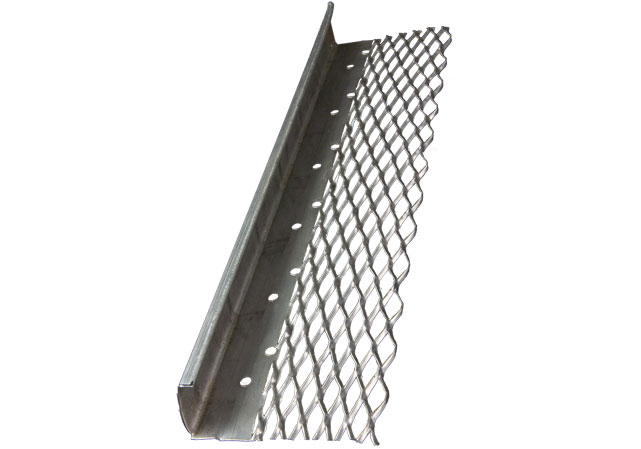
Cat face- A void in the finish coat on a plaster wall. Catfaces are filled with white mortar when a wall is troweled. A cat face texture is when cat faces are left intentionally, usually with sand in the finish plaster, or on stucco.
Channel iron-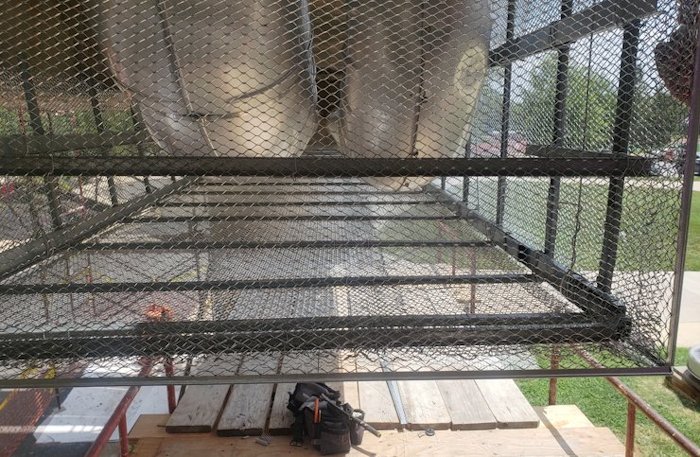 Metal channels usually in 1-1/2" or 3/4" width for framing for metal lath and plaster. Used
for suspended plaster ceilings, soffits, and years ago, even for wall framing. This provides super a durable product as reinforement for plaster.
Metal channels usually in 1-1/2" or 3/4" width for framing for metal lath and plaster. Used
for suspended plaster ceilings, soffits, and years ago, even for wall framing. This provides super a durable product as reinforement for plaster.
Chopping mud-Mixing mortar with a hoe.
Corner bead-
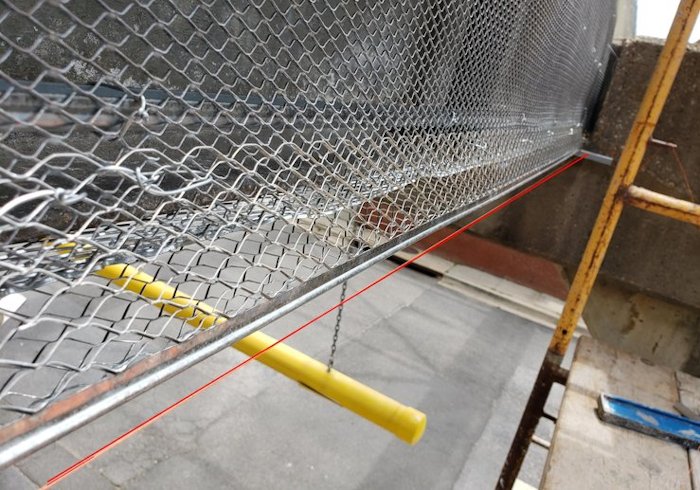
Cornerite-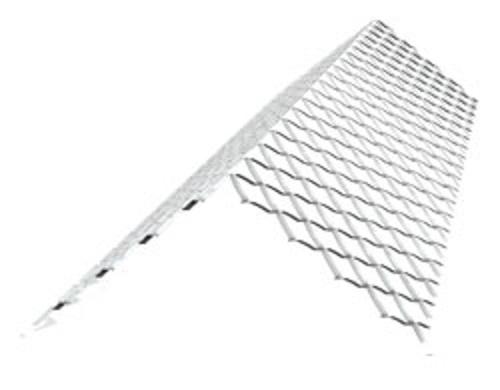 A bent strip of metal lath
made for reinforcing angles. The can be used for reinforcing arrises when no corner bead is used.
A bent strip of metal lath
made for reinforcing angles. The can be used for reinforcing arrises when no corner bead is used.
Darby-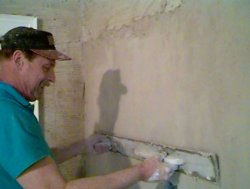
Dots-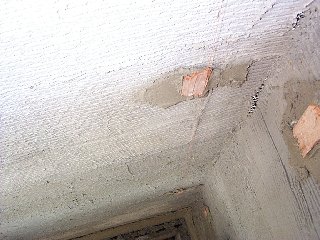 Dots are blobs of mortar, pieces of wood, cardboard, or what ever to set the wall thickness. Dots are usually set with a string line
or level. Screeds are set by connecting the dots with mortar and a rod. For example, dots are usually set 5 feet apart, and screeds are set with a
6 foot rod. The screeds can be set 5 feet apart, and wall filled in and rodded off between the screeds.
Here's a link for more:
Dots are blobs of mortar, pieces of wood, cardboard, or what ever to set the wall thickness. Dots are usually set with a string line
or level. Screeds are set by connecting the dots with mortar and a rod. For example, dots are usually set 5 feet apart, and screeds are set with a
6 foot rod. The screeds can be set 5 feet apart, and wall filled in and rodded off between the screeds.
Here's a link for more:
Flashing-Metal over windows, roofs, etc. to prevent water infiltration.
Float-A flat thing with a handle on top. These are made for rubbing down plaster or stucco.
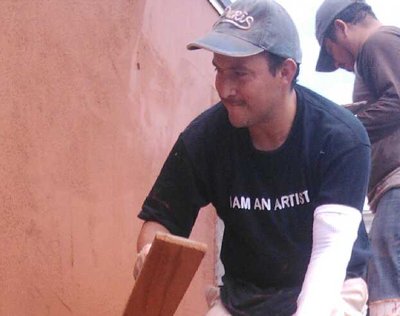 A sponge rubber float is used to rub down a color stucco finish.
A sponge rubber float is used to rub down a color stucco finish.
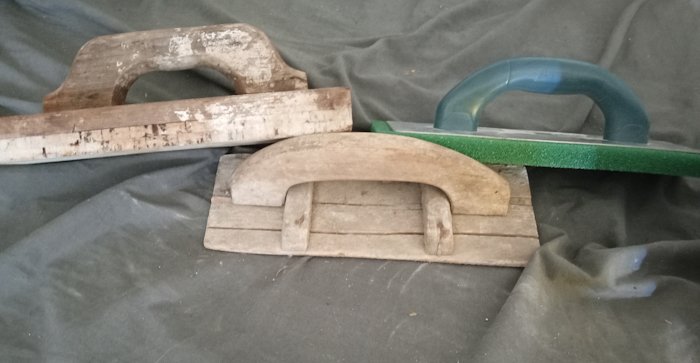 Here are three different floats. A cork float was used years ago for rubbing down a stucco basecoat and finish coats. The old
houses in New Orleans were rubbed with cork. A sponge rubber float is used for rubbing down a stucco finish. The old wood float
was probably used to rub a lime basecoat. I like how the ribs are horizontal. There are other floats. A magnesium float is
used for concrete, and works well for knocking down a Spanish texture. Plastic floats are used for synthetic finishes.
There are other kinds of floats, but hopefully you get the idea.
Here are three different floats. A cork float was used years ago for rubbing down a stucco basecoat and finish coats. The old
houses in New Orleans were rubbed with cork. A sponge rubber float is used for rubbing down a stucco finish. The old wood float
was probably used to rub a lime basecoat. I like how the ribs are horizontal. There are other floats. A magnesium float is
used for concrete, and works well for knocking down a Spanish texture. Plastic floats are used for synthetic finishes.
There are other kinds of floats, but hopefully you get the idea.
Filigree-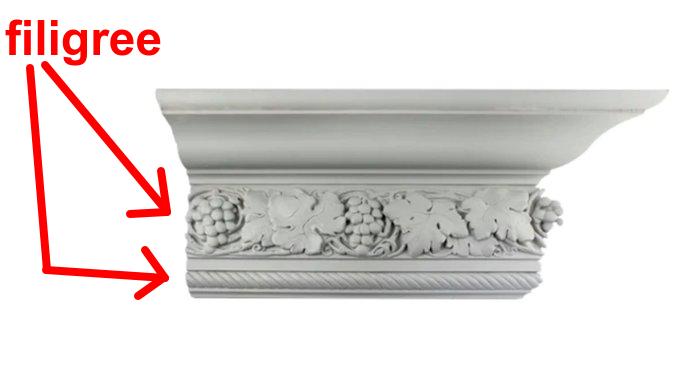 The cast ornamental detail on a molding.
The cast ornamental detail on a molding.
Gauge-1. A batch of white mortar, that is gauging plaster and lime, mixed on a mortar board.
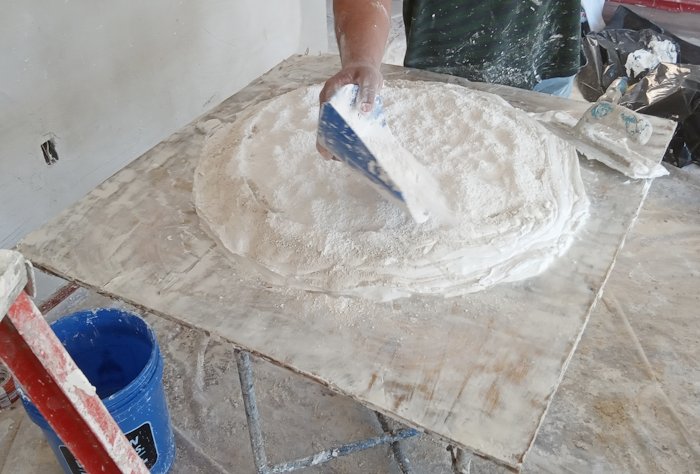 2. A tool for measuring, not a rule. For example, a small piece of 1/2" sheetrock used to measure a half inch door margin, that is the distance
the door frame extends out past the stucco. Gauges are used for various measurements in plastering.
2. A tool for measuring, not a rule. For example, a small piece of 1/2" sheetrock used to measure a half inch door margin, that is the distance
the door frame extends out past the stucco. Gauges are used for various measurements in plastering.
Gauging plaster- White plaster mixed with lime putty on the mortar board for white coating plaster.
Hardwall-Hardwall is gypsum plaster for brown mortar, named after the Gold Bond brand name. USG brand is referred to as Red Top plaster, not Red Top finish plaster.
Hawk-
 A mortar holder. The flat thing with a handle on the bottom. Hawk and trowel is the name of the team.
A mortar holder. The flat thing with a handle on the bottom. Hawk and trowel is the name of the team.
Lime putty-Lime that is mixed or soaked in water. Lime is gauged with gauging plaster for the white coat, or finish coat of plaster.
Mitre rod-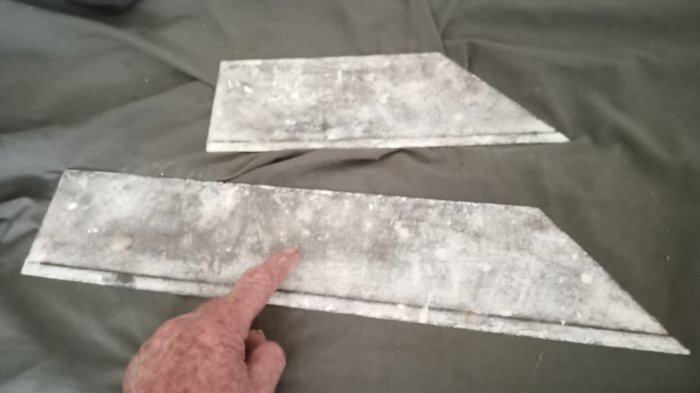 or miter rod. A sharp straight edge for working with moldings.
or miter rod. A sharp straight edge for working with moldings.
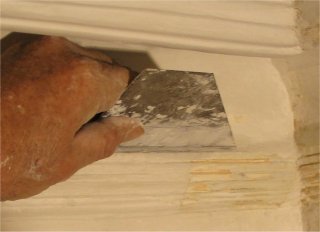
Mortar board-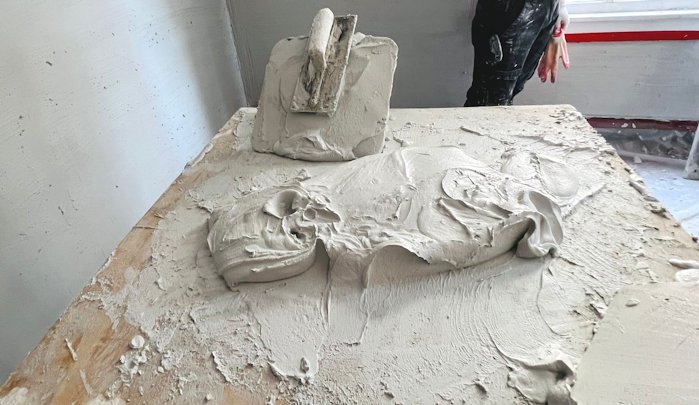 A place to put mortar until it can be taken off with a hawk and trowel.
A place to put mortar until it can be taken off with a hawk and trowel.
Mortar board stand-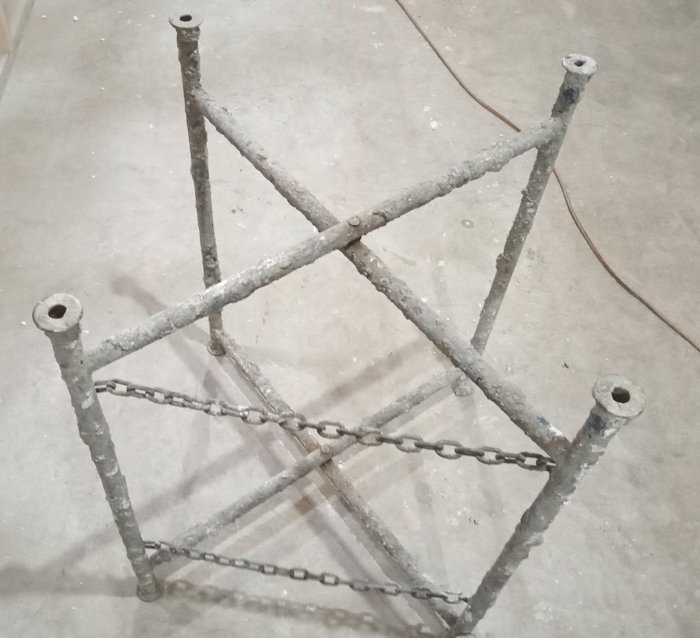 A stand for holding up the mortar board. The name of the team is board and stand. A homemade stand can be made of two by fours, or other things. A garbage can works good, also.
A stand for holding up the mortar board. The name of the team is board and stand. A homemade stand can be made of two by fours, or other things. A garbage can works good, also.
Neat plaster-Neat plaster is Gypsum plaster for brown mortar with no sand (or perlite). For example: Dry mix one bag of neat plaster with 20 shovels of sand. Also, wood fiber plaster is made to be used neat, because the wood fiber is the aggregate. For example: Wood fiber plaster should be used neat on metal lath, but up to 9 shovels of sand can be used for plastering blocks.
.Poor (mortar)-More sand in the mortar. For example: a poor mix of 25 shovels of sand to a bag of portland cement can be used over block.
Putty coat-California for the white coat, or the finish coat plaster.
Rich (mortar)- Less sand in the mortar. For example: A rich mix of 16 shovels of sand to a 100 pound bag of plaster is good for scratching metal lath ceilings.
Rod-
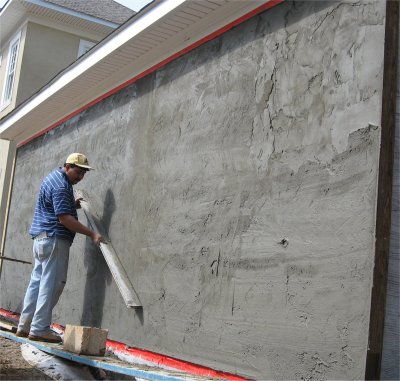 A straight edge for straightening a plaster wall. These are made from a magnesium aluminum alloy. A straight board, such as a one by four, can also be used.
White pine or mahogany works the best. Most hardwood warps overnight. Redwood is good for interior plaster, but not for cement.
Cement mortar tends to eat holes in the redwood.
A straight edge for straightening a plaster wall. These are made from a magnesium aluminum alloy. A straight board, such as a one by four, can also be used.
White pine or mahogany works the best. Most hardwood warps overnight. Redwood is good for interior plaster, but not for cement.
Cement mortar tends to eat holes in the redwood.
Running mold- A template made for running moldings in place.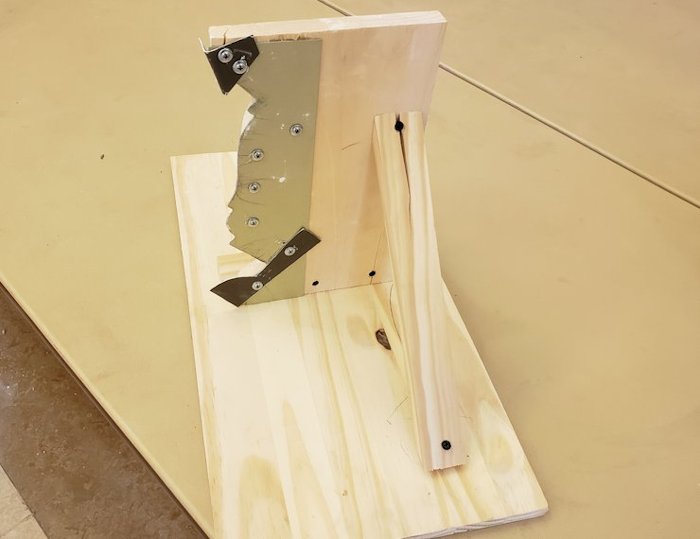 Here's a link for an example of how this is done:
Here's a link for an example of how this is done:
Scarifier-
Also called a scratcher or a rake, made for scoring the scratch coat for a good bond for the next coat.
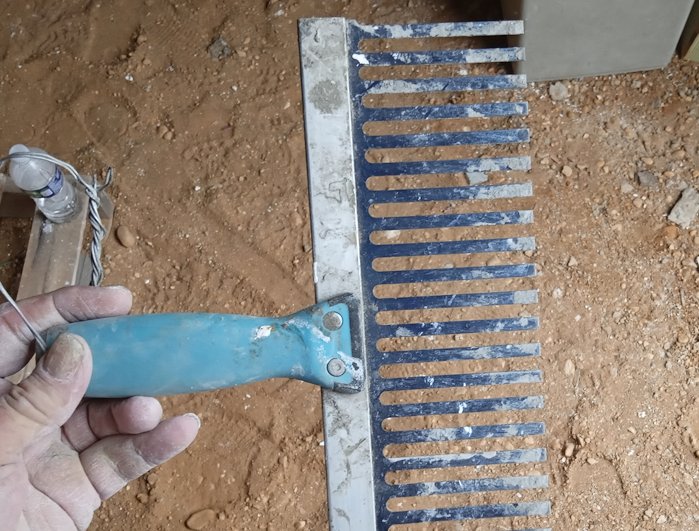 A homemade scarifier made from an old refrigerator rack:
A homemade scarifier made from an old refrigerator rack:
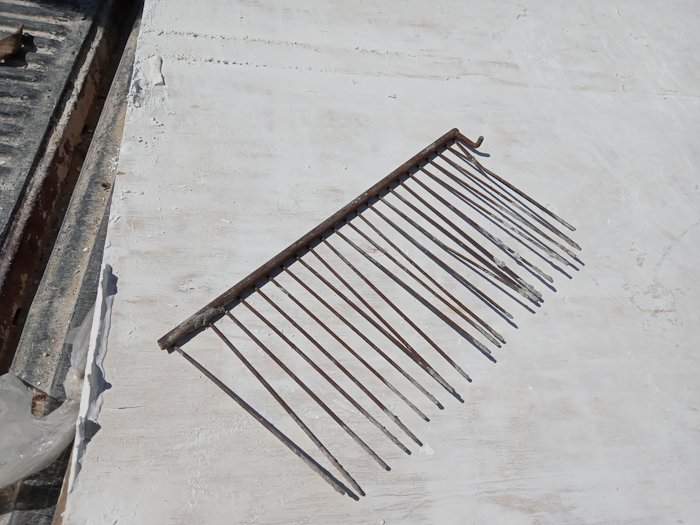
Screed-A screed a long strip of mortar, wood or metal defining the wall thickness and providing a straight line (or curved line)
to fill the wall to.More about screeds here...
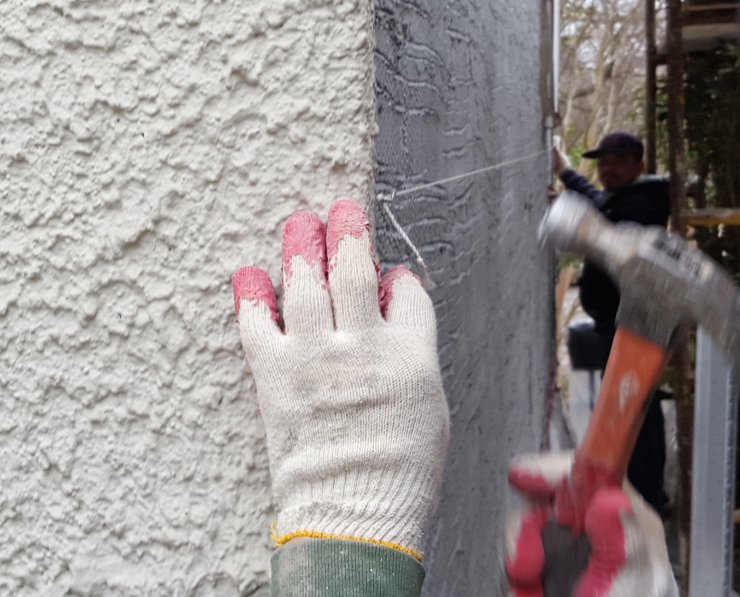 Here a string line is set to set a horizontal screed about 5 feet high.
Here a string line is set to set a horizontal screed about 5 feet high.
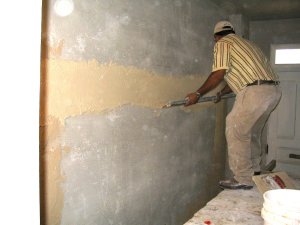 Here a screed is set with brown mortar for interior plaster.
Here a screed is set with brown mortar for interior plaster.
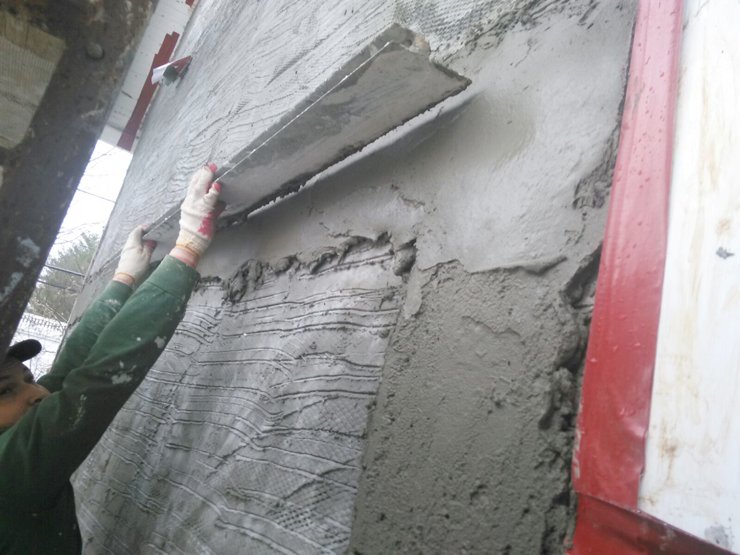 Screed is set for stucco with a 6 foot rod.
Screed is set for stucco with a 6 foot rod.
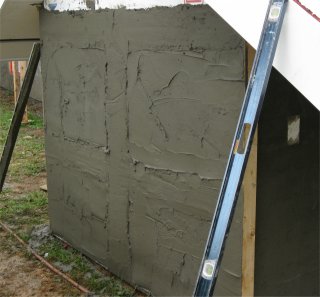 Screeds are set horizonally and vertically.
Screeds are set horizonally and vertically.
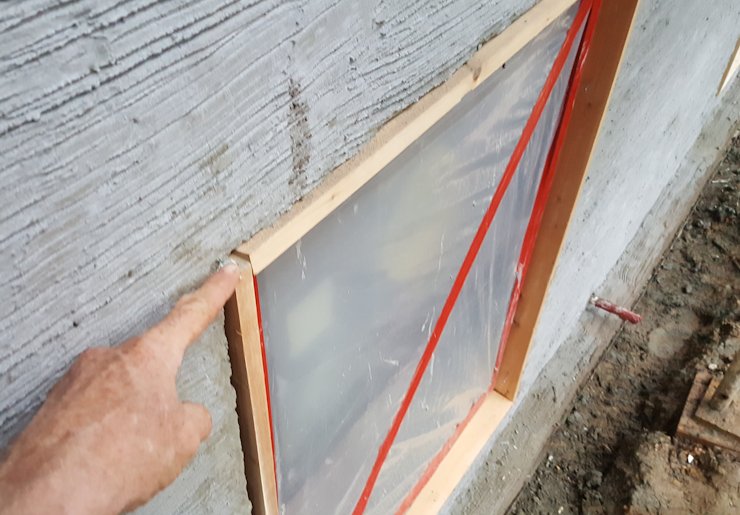 Wood screeds are set for these window returns.
Wood screeds are set for these window returns.
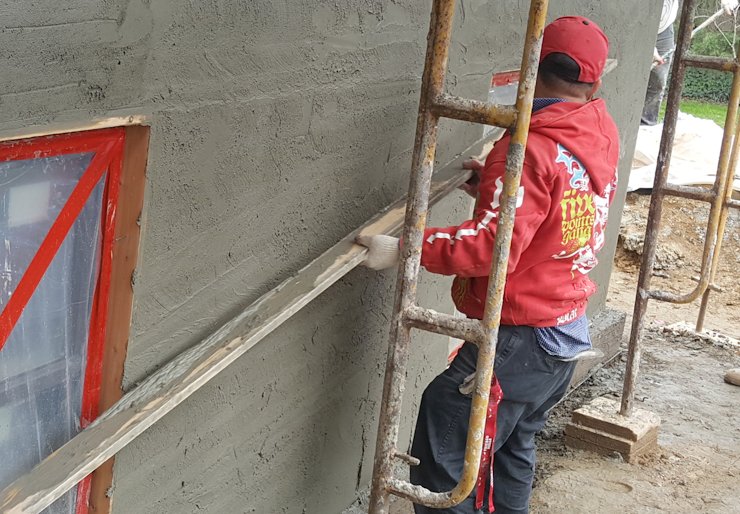 Wall is rodded off between the screeds with a 10 foot one by four.
Wall is rodded off between the screeds with a 10 foot one by four.
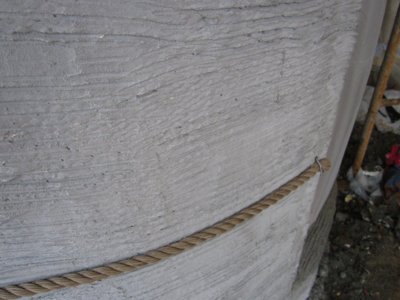 Ropes are used for round screeds. More about Swami's rope trick here...
Ropes are used for round screeds. More about Swami's rope trick here...
Scratch-Putting mortar on the wall is scratching on mortar. A scratch coat on metal lath is the first coat of mortar on metal lath.
Scrub-California for finishing stucco, because of the scrubbing motion of a float. A float finish is called a scrub coat. Also, the color coat is called scrub. For example, " We put on 40 yards of scrub yesterday." Yards means square yards, or 9 square feet. Square yards are easy to calculate in Southern California because most of the houses are 9 feet high, so one linear foot is one square yard.
Soffit-A short ceiling, for example the ceilings under an eave of a house, or the bottom side of a duct chase.
Splay angle-An angle more than 90 degrees. Follow this link for more about splay angles
Slicker-A short flexible straight edge. These are great for truing up the brown coat after rodding off the wall, holding the slicker
square to the wall. There are a must for patching plaster. A good slicker can be made from a scrap piece of weep screed, or a piece
of redwood siding.
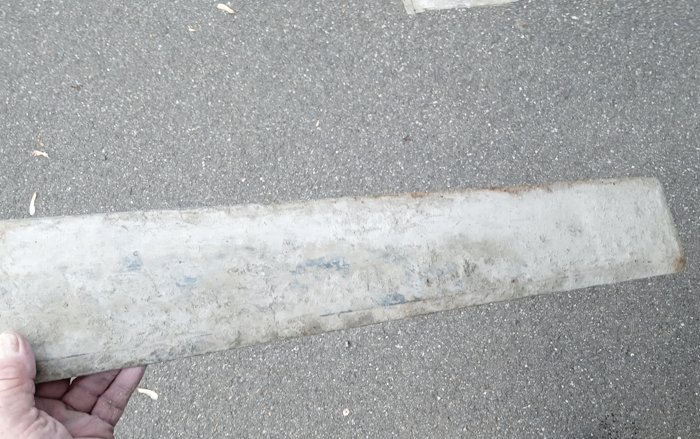
Weep ground-A weep ground is a casing bead with holes drilled in it to allow water to drain out the bottom of the wall.
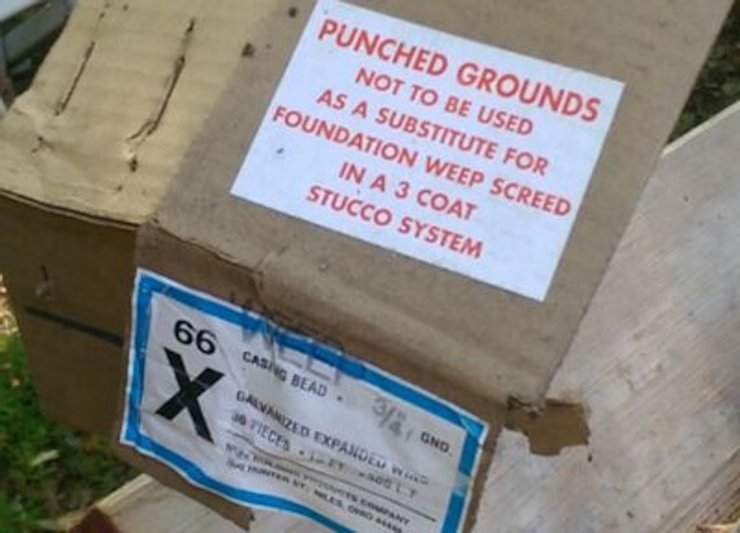
Weep holes-Holes in the bottom of a retaining wall, weep grounds, sliding doors, whatever to let water out.
Weep screed-
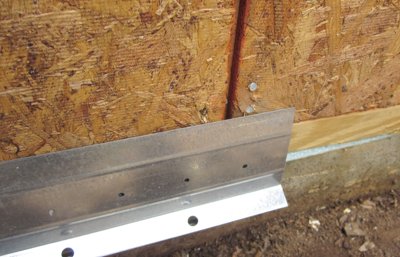 Also known as a foundation weep screed, is a metal screed that is made for slab houses. The metal screed projects out 3/4" from the bottom and has holes for water drainage. Note there are small holes in the metal flange. These are provided to nail to the wood framing. The metal
flange is flashing to prevent water from running done and collecting on the concrete. Water that sits on the concrete can rot the bottom
plate, or the horizontal 2 x 4 that supports the house. The flange is then overlapped with tarpaper, or taped to whatever vapor barrier there is.
Also known as a foundation weep screed, is a metal screed that is made for slab houses. The metal screed projects out 3/4" from the bottom and has holes for water drainage. Note there are small holes in the metal flange. These are provided to nail to the wood framing. The metal
flange is flashing to prevent water from running done and collecting on the concrete. Water that sits on the concrete can rot the bottom
plate, or the horizontal 2 x 4 that supports the house. The flange is then overlapped with tarpaper, or taped to whatever vapor barrier there is.
White coat- The finish coat of plaster. White mortar is lime and gauging plaster or lime and molding plaster.
White coat brush-
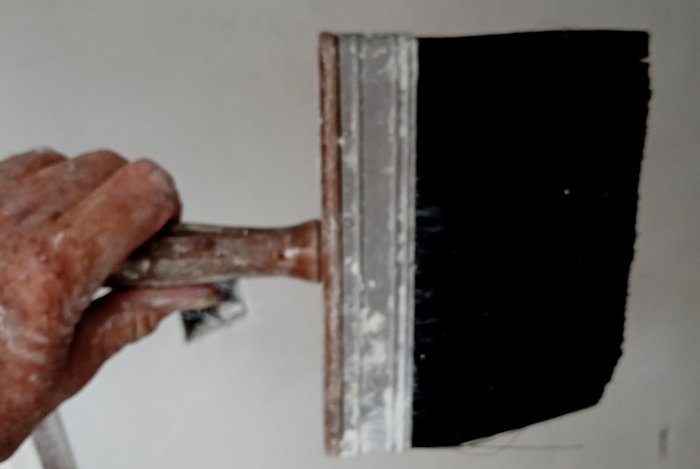 A brush made for applying
water to the white coat when troweling the wall smooth. Applying water prevents the trowel
from sticking to the work. A white coat brush has china bristles.
A brush made for applying
water to the white coat when troweling the wall smooth. Applying water prevents the trowel
from sticking to the work. A white coat brush has china bristles.
Thanks so much dear readers, for reading all these years, and for all the comments.